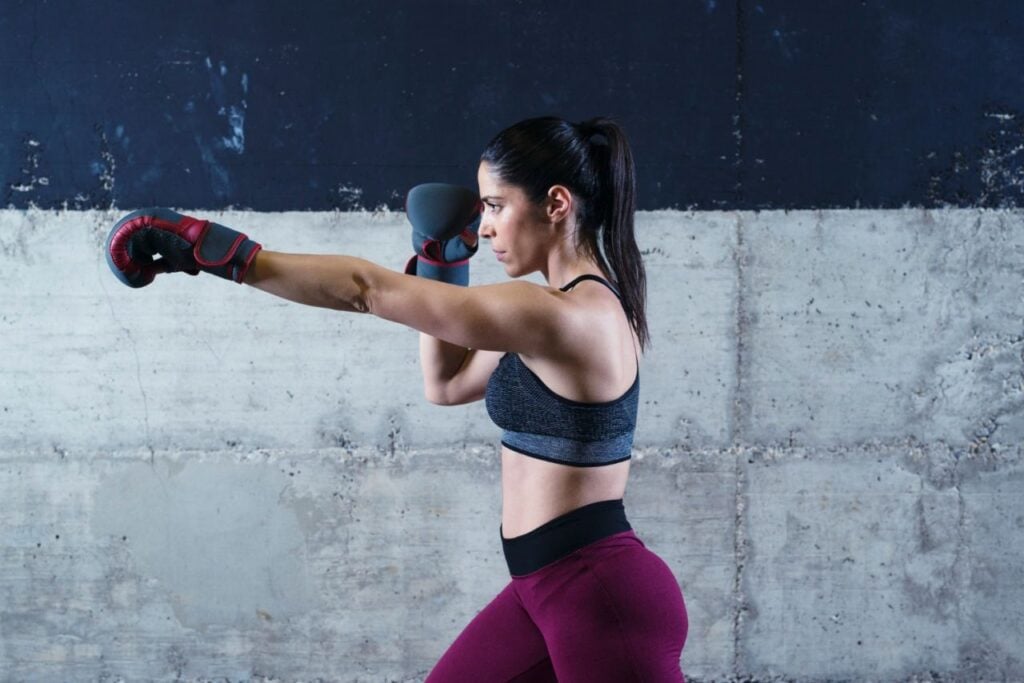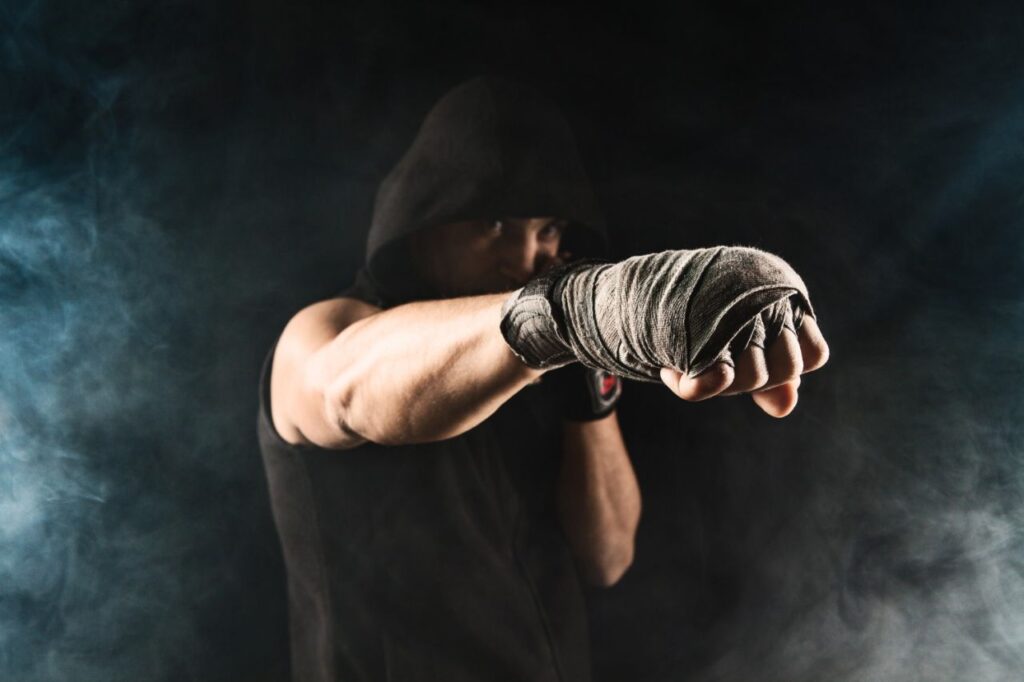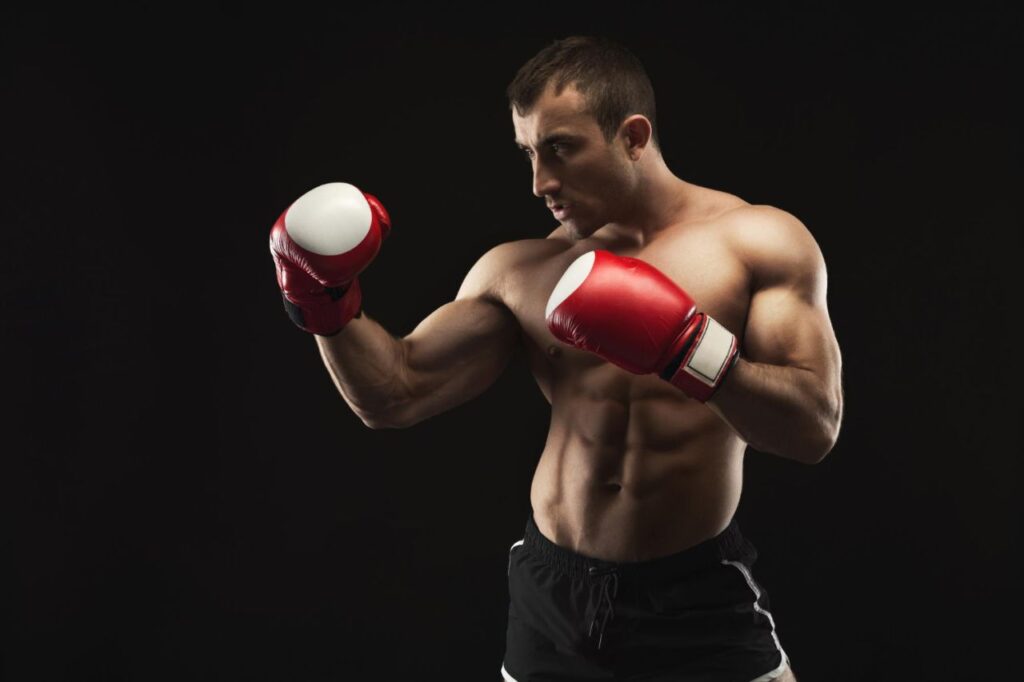Boxing may look intimidating, but it doesn’t have to feel that way. Arming yourself with a few basic moves before your first boxing class or training session will set you up for success in the ring.
If you want to start boxing, the first and one of the most important things you have to learn is the proper boxing stance. Without it, you can’t move, throw punches, and different yourself effectively.
You may not devote importance to it initially, but believe me, the right stance in boxing is the basis of everything you do in the ring or during your boxing workout.
Finding the perfect boxing stance is the foundation for any boxer. Stance maketh the boxer.
And for beginners, getting the stance right is the most important element. The first thing that you should NOT do is copy the stance of your favourite boxer.
You have to choose the stance that can bring your strengths to the forefront and hide your weaknesses as much as possible.
There are two basic stances; Orthodox boxing stance and Southpaw boxing stance. Orthodox is for right-handed boxers, and the southpaw is for left-handed ones.
Why Is A Boxing Stance So Important?
It cannot be overemphasised how important it is to have a good stance. A good stance will help you attack and defend with balance. An athlete should not lose their balance while throwing a punch. If one is off balance, one is more likely to hit an opponent.
You can throw a broader range of powerful punches by standing in an ideal manner without leaving yourself too vulnerable.
Getting your basic stance right will give you more strength, balance, and mobility.
The boxer is constantly in motion to solve his tactical ideas to best apply his imagined movement patterns in space and time concerning his opponent. The most important component of agility is footwork, which may be combined with the movement of other body parts.
But, all these movements are impossible without the right stance.
The conventional boxing stance helps maintain balance and is essential for offensive and defensive techniques.
The importance of a boxing stance can be understood by eight simple words:
- Power
- Defence
- Range
- Balance
- Flexibility
- Security
- Stability
- Mobility
Mistakes to avoid
- The possibility of getting smacked in the mouth increases when your chin is raised higher than your raised hands.
- You are taking a step where you lose track of the imaginary line connecting the toe of your front foot to the heel of your rear foot, thereby compromising your balance.
- A heavy front leg makes you more vulnerable to attack because your body weight is transferred to your front leg.
- I am turning the shoulders in such a way as to present a bigger target for the opponent.
- It is being unable to move easily because you are flat-footed.
- Boxers who lean back too much will lose their balance.
- Because their feet are anchored to the ground, people with wide stances usually have to jump whenever they want to move.
Different Boxing Stances
All the different stances of boxing generally utilise the same principles mentioned above.
The only difference is that they will vary in hand positioning, foot placement, and body angle.
Where you place your hands is determined by your offensive and defensive needs throughout the fight. Your foot placement determines how you should position the rest of your body.
For example: if you’re using foot positioning that doesn’t allow for much mobility, you probably shouldn’t pair that up with a hand positioning that offers low defence.
Likewise, if you want to use offensive hand positioning for chasing down your opponent, you probably don’t want to use a foot placement that won’t let you move forward very well. Ultimately, the perfect boxing stance is the one that fits your style and your situation.
Orthodox
Orthodox stance, as mentioned above, is for right-handed boxers. You have to stand with your left foot and left hand in front of you. So basically, you have to place your weaker side before your opponent.
Orthodox Boxing Stance Pros
Being a right-handed fighter is more common; most likely, you will match up with another right-handed fighter, making angles easier to predict. You create angles with punches and movement easier.
Orthodox Stance Benefits
- Easier access to quality training. Boxers who use the orthodox stance have it easier for training, including coaches, simply because there are more right-handed people. That means it’s easier to find a coach that knows how to train an orthodox fighter.
- The advantage in the ring. Also, because being right-handed is more common, you may have an advantage in the ring as you’ll be more likely to box other orthodox boxers, which means you’ll have a better idea of what their moves will be. That increases the odds of being able to guess your opponent’s next turn or twist, boxing more intuitively.
- Painful hits. Due to positioning, it’s easier to get a painful liver punch in as you’ll be closer to your opponent’s right side, bringing a big advantage as it’s a very effective spot to hit hard.
Orthodox Boxing Stance Cons
Matching up against a southpaw is less likely, but when you do, your angels will need adjustments, from the punches you see to the punches you will throw.
This also includes defensive movements.
Southpaw
Southpaw stance is for left-handed boxers. Keep your right foot and right hand forward. Why keep your weaker side placed ahead? You may start thinking that, and the answer is that you have to generate power from your lead hand, and you can’t do that if it is held in the front.
So you jab with your off-hand and throw powerful crosses with the lead hand.

Southpaw Boxing Stance Pros
You are well prepared to see more orthodox fighters; time and time, you learn their patterns, angles, and combinations more easily.
Southpaw Stance Benefits
- Element of surprise. As there are fewer left-handed people, making up only around 10 per cent of the population, southpaw boxers have an advantage in that they can often take their opponents by surprise. Their movements are completely different, so most orthodox boxers won’t have insight into what their training is like, giving the southpaw the upper hand.
- Control and comfort. The southpaw style is considered more open, making for a more comfortable position. A boxer using a closed orthodox stance has a weaker defence, giving more control to the southpaw. Their lead foot can more easily be used to distract their opponent, making their opponent feel off-balance.
- Better long-range punches. Because a southpaw can build power in both their left and right hands, their jabs are better, while their dominant hand is saved for harder punches. They typically outperform at long-range punches.
Southpaw Boxing Stance Cons
You see more orthodox fighters and must be aware of butting heads more frequently, tripping over the lead foot. You don’t see many southpaws either and don’t like facing each other either
Although you need to have the flexibility to shift your weight forward or backward, toward the lead foot or the rear foot, try to maintain a centre of gravity by placing more of your weight toward the lead foot, at about a 55/45 per cent ratio.
Upright Stance
Adopt an orthodox stance by standing with your legs shoulder-width apart and your right foot approximately half a step back from your left foot. Point both feet very slightly inward and lift the back heel about 3 inches.
Position your left fist at eye level about 6 inches in front of your face. Put your right fist next to your chin, pulling your elbow in toward your ribcage. Lower your chin toward your chest to avoid punches to the jaw.
Crouching Stance
Instead of standing upright, you can crouch or semi-crouch during a boxing match. Your body is positioned similarly, but your knees are bent partially or totally. When crouching, lean slightly forward and keep your feet close together to stay balanced.
Semi-Crouch Stance
The semi-crouch stance is a variation of the crouch stance. As with the crouch stance, the fists are raised in front of the boxer’s face, with both feet placed firmly on the ground of the ring.
The lead hand and foot are also placed in front, while the back is straight.
The boxer may sometimes lean forward slightly. As with the crouch stance, this stance is good for protecting the face from any incoming blows.
Wide Stance
When using the wide stance, your feet should be stretched out more than the basic stance. Also, your knees should be bent a little bit more. That way, you will be much more stable, and you will generate more power (because of the leverage your lowered stance gives you).
The wide stance is great for hard punchers and boxers who like to counter—the fighters who use it trade mobility and reach for power.
Pros: More power in your punches and better balance.
Cons: Poor mobility and lack of reach.
Sideways Stance
This stance is used in martial arts such as taekwondo and karate. But in some situations, it can be applicable in boxing also. That’s because it gives you great mobility and range, especially for your lead hand.
The other benefit of the sideways stance is that you become a narrow target when you use it, so it’s harder for your opponent to catch you.
Pros: Great stance for creating and maintaining a distance and for “in-and-out-movement”. More reach with the jab and more power in the rear hand cross.
Cons: You can easily lose balance when caught with hooks (especially left hooks) or even when throwing rear hand hooks. You don’t have much power in your lead hand, so your only real weapon is your rear hand cross (which is far away from the opponent, so sometimes it’s hard to catch him with it).
Squared Stance
The squared stance is commonly used in Muay Thai. I like it because you have power in both your hands (unlike the sideways stance).
In addition, this stance can be effective when your opponent is trapped against the ropes because you can use the squared stance to put even more pressure and prevent him from escaping. And, of course, to land powerful shots with both your hands.
Pros: You can throw powerful shots with both your hands and you can easily move to your left and right or pivot at an angle.
Cons: This stance leaves your body open for punches because you become a bigger target when using it, so it’s harder to defend yourself everywhere. Another disadvantage of the squared stance is that you can lose balance easily if your opponent pushes you back or gets a hard punch in the head. That’s why I recommend using it mainly when the other boxer is on the ropes. There you can lean on him to keep your balance.
Something similar happened in the fight between Maidana and Mayweather, where Marcus Maidana used a squared stance to press Mayweather against the ropes and land hard right overhands.
The Basic Guard
Don’t be fooled by its name — the basic guard is one of the simplest and most effective guards a boxing student must learn. The basic guard provides a great platform for aggressive fighters always looking to attack and defend from.
Boxer-punchers such as multiple-time boxing World Champion Manny Pacquiao and Marvin Hagler use the basic guard, perfect for launching their flurries.
How to do the basic guard: Hold your left arm a bit further out from your face and lower it slightly. Your right arm should be relaxed and held a bit lower as well. Keep your chin down and your eyes forward.
Pros: Your hands are at the perfect height to launch attacks and defend them.
Cons: Your hands and head should be very active — work on slipping and dodging punches. The lowered hands will leave your head exposed.
The Peek-A-Boo Guard
Most famously utilised by multiple-time Boxing World Champion Mike Tyson, the peek-a-boo guard requires the boxer to put his hands in front of his face. This guard offers the most protection out of all guards while still providing full access to all defensive and offensive techniques.
As a beginner, this is one of the first guards you will learn.
How to do the peek-a-boo guard: (for orthodox stance) Raise your left arm until it rests on your left cheekbone. Your right fist rests on your right cheekbone, slightly lower than your left arm. Hold your elbows tight to your body and tilt your head forward with your chin to your chest. Your forearms must be straight up, protecting your jaw, neck and upper chest. Thus, you create a wall with your fists and forearms to hide behind and open to throw a punch.
Pros: Great for defending against jabs and shots to the head.
Cons: Obstructs your vision, very predictable.
The Philly Shell/ Shoulder Roll
A variation of the cross-arm guard, the Philly shell, utilises a fighter’s shoulder to deflect punches while the other arm blocks and counters. It is an advanced guard suitable for counterpunchers because it gives you just enough coverage so you can freely move your arms to attack.
Great counterpunchers such as Floyd Mayweather Jr., Sugar Ray Leonard, and James Toney are known for utilising the Philly shell.
How to do the Philly shell: (orthodox) Place your lead arm across your torso between your belly button and chest while your hand rests on the opposite side of your torso. Your backhand is placed on the side of your face while your lead shoulder is tight against the side of the face.
Pros: You’re in a perfect position to counter punch, allowing you to switch from defence to offence quickly.
Cons: You must be athletic and well-conditioned to effectively execute this style because of the constant movement required. When stationary, you become prone to attacks, especially jabs on the exposed shoulder.
What is a Proper Boxing Stance?
A boxing stance understands balance and mobility with foot placement and hand placement. You have two types of boxing stances to choose from, orthodox and southpaw. Styles make fights, so choose wisely! Of course, I’m kidding; find what works best for you, and have fun trying both!

Usually, the dominant hand you use daily will get put behind you and used as your power punch. Your feet will line up with your hand placement. For example, left foot and left hand in front, right foot and right hand behind you.
Perfect Your Stance
You can consider this the actual first move because, without proper stance, you’re nowhere. Stand with your feet shoulder-width apart, and take a step back with the leg that’s on your dominant side (if you’re right-handed, that’s your right leg.)
The toes of the foot that’s in front should align with the foot’s heel at the rear. Keep a slight bend in your knees, and turn your head towards your front shoulder. Keep your fists up under your eyes to protect your face and chin downward.
The perfect boxing stance is necessary for a variety of reasons:
It folds your body inward, making you appear smaller and stay covered. This gives your opponent less surface area to hit
You maintain your balance better in this position and can put the power from your hips into your punches.
Attack and defence both become easier due to your fists being placed close to your face: you’re free to hit your opponent or protect yourself quickly.
FAQs
What Stance Do Most Boxers Use?
The Orthodox Stance
Because it favours the stronger, dominant side—often the right side, see laterality—the orthodox stance is the most common in boxing and MMA. Right-handed boxers mostly use it. Many boxing champions have fought in an orthodox stance.
What Is The Most Common Boxing Style?
Pressure Fighting
Pressure fighting is a highly effective style that is perhaps the most common in boxing. Well-known boxers in the sport’s history who were pressure fighters include Manny “Pacman” Pacquiao, Roberto Duran, and Julio Cesar Chavez.
Why Is It Called Southpaw Boxing?
Supposedly, late 19th-century ballparks were laid out so that the pitcher looked westerly when facing the batter. The throwing arm of a left-handed pitcher would then be to the south-hence the name southpaw.
How Do You Pick A Boxing Stance?
Position your feet so the big toe on your left foot and your right heel align with your target. If you’re left-handed, place your right foot forward and your left foot back in what’s called the southpaw stance. Then, using the clock analogy, point your right foot at 11 o’clock and your back foot at 8 o’clock.
How Many Guards Are There In Boxing?
There are three main defensive positions (guards or styles) used in boxing: All fighters have variations in these styles. For example, some fighters may have their guard higher for more head protection, while others have their guard lower to better protect against body punches.
- Find a gym. Boxing gyms aren't typically found in the yellow pages, but there are resources on the internet that can lead you in the right direction. ...
- Be sure the gym is within striking distance. ...
- Be open-minded. ...
- Choose your coach carefully. ...
- Do judge the gym by its cover.
So, can boxing be self-taught? Boxing can be self-taught but it's not the quickest and most effective way to become better at the sport because you aren't able to tap into the knowledge of a boxing coach who would be able to help you one to one.
Best Age to Start
Specialists in sports medicine believe that boxing classes are better to start from 9-10 years. Starting too early could result in putting the student off, as boxing is hard work and not always as fun as team sports, such as football or rugby.

